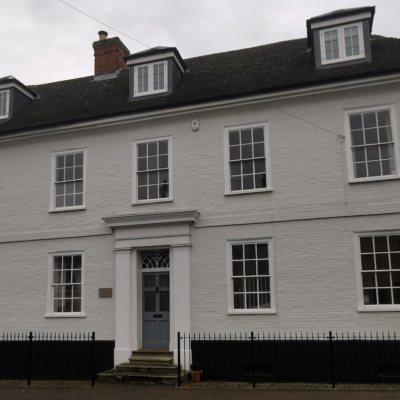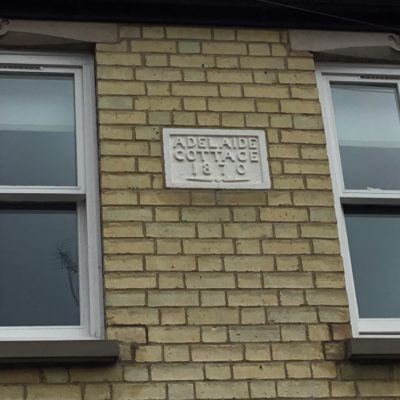Search by topic
- archaeology
- architecture
- bricklayer
- Building of Local Interest
- carpenter
- church
- crime
- dressmaker
- fire
- Great Eastern Railway
- listed building
- medieval
- oral history
- Public House
- Rattee & Kett
- Religious House
- Roman
- scholar
- school
- Then and Now
- tudor
- women
- work
- world war one
- world war two
Search by text
28 Ainsworth Street, The Bee Hive
The Bee Hive
Number 28 is an end-of-terrace property on the corner of Stone Street and Ainsworth Street.
Spalding’s Directory for 1878 lists ‘Flack, E., Publican’ on Ainsworth Street, but there are no house numbers to confirm that this is the Bee Hive. As the Flack family are present in the 1881 census we can assume that the Bee Hive was constructed before 1878, but it must have been after 1871 as there is no mention of E Flack or any publicans on the 1871 census.
1881 census
George Flack, head, 50, beerseller, b. Hedingham, Essex
Henrietta Flack, wife, 40, b. Broughton, Huntingdonshire
George Flack, son, 16, apprentice to confectioner, b. Bury, Suffolk
George Flack appears on the Electoral Registers living at no. 28 between 1880 and 1883. On the 1881 census, the Bee Hive isn’t named, but George Flack is listed as a beerseller so he was presumably selling beer from this property.
The couple moved to Sawston by 1891, but in 1901 they were back in Cambridge, living in Edinburgh House on Hooper Street, where George was a caretaker and Henrietta was a matron.
Electoral Registers for 1883–1884 show a David Smith living at the property.
Electoral Registers for 1884–1887 show a Robert Langram living at the property.
Electoral Registers for 1888–1890 show a Samuel Braybrook living at the property. This is likely to be the same man who lived at 19 Ainsworth Street in 1881 and 30 Ainsworth Street in 1891–1901.
1891 census
William Finch, head, 53, painter & publican, b. Houghly, Suffolk
Elizabeth Finch, wife, 45, b. Fen Ditton, Cambridgeshire
John Finch, son, 28, plumber, b. Rattlesden, Suffolk
William Finch appears on the Electoral Registers living at 28 Ainsworth Street between 1890 and 1894.
On the 1891 census, this property is listed as the Bee Hive and is listed in some trade directories as a grocery store as well. This pub would have had a lot of competition, with the Malt & Hops directly opposite, and the Geldart and the Claremont Arms nearby.
On the census, the word ‘pub’ is written by Elizabeth Finch’s name, suggesting that she worked as a publican alongside her husband.
By 1901 the couple were living in Dagenham where William was a general shop keeper.
The census officer has written that John Finch is their son, but other census records suggest that he was actually their nephew. John married Harriett Riches on 23 Feb 1891 in her home parish of Dersingham, but she isn’t listed on this census with him: she was still at home with her mother in Dersingham.
In Spalding’s Directory for 1895, the Bee Hive is run by John Neaves, listed as a publican, although the Electoral Register shows nobody registered as living at no. 28 in that year.
In 1897 the Bee Hive was advertised to let (Saffron Walden Weekly News, 21 May 1897):
The Bee-Hive, Ainsworth Street, Off-licensed Beerhouse, with Bake Oven attached, – Apply Apthorpe and Son, Brewers, Cambridge.
1901 census
Charles A Phillips, head, 29, bricklayer, b. Swansea, Glamorgan, Wales
Ada Phillips, wife, 28, b. Cambridge
There is no mention on the census of the property being the Bee Hive. Charles Phillips’ World War I documents tell us that Charles and Ada Phillips were living in South Street by 1915.
A news story from 1903 (Cambridge Independent Press, 14 Aug 1903) tells us that the head of household was now a Robert Allen. An application had been made under the Public Health Act 1875 ‘for the removal of a man named Robert Allen, of 28 Ainsworth Street, who was suffering from smallpox, to the huts on Coldhams Common, at the expense of the Corporation, as the man had not proper lodging or accommodation as required by the Act.’
It then went on to describe Mr Allen’s situation:
The house was on Ainsworth Street and six persons resided there. There were three bedrooms. The man could occupy one, the woman the other, and the children the third, but the only person to attend upon the man, to look after the children, and to answer the door, was the woman. In a case like this, when the malady was a highly infectious one, that was not right.
The Doctor informed the court that the house was a beerhouse, and the Chief Constable said that the house was closed and the brewery was giving Mr Allen £1 a week. However, the Doctor contradicted this, and said:
[W]hen passing through Ainsworth Street on Thursday night, to see another patient [I] saw the door to the house open and people standing at the bar.
The Chief Constable said that there was no power to close public houses as it was the responsibility of the brewery, in this case, Lacon & Co. The application to remove Mr Allen to the smallpox huts was granted.
Kelly’s Directory for 1904 tells us that the head of household was now John Ellum, grocer and beer retailer.
In the 1910 Land Tax records, the Bee Hive Inn is listed as an Off License, Beerhouse and Premises. Both this pub and the pub directly opposite were owned by Lacon & Co, a brewery in Great Yarmouth.
1911 census
John Ellum, head, widower, 51, green grocer etc, own account, b. Gt Shelford, Cambridgeshire
Ethel Ellum, daughter, 19, b. Cambridge
Walter Barker, nephew, 17, errand boy for drapers, b. Cambridge
In the 1913 Street Directory John Ellum is listed among the greengrocers and the public houses. In Kelly’s Directory for 1916 he is just a grocer.
1921 census
John Ellum, head, 61, widower, grocer, own account, b. Great Shelford, Cambridgeshire
Ethel Ellum, daughter, 29, home duties, b. Cambridge
1939 register
Robert E Thoroughgood, b. 14 Mar 1881, licensed victualler
AliceThoroughgood, b. 6 Aug 1884, housewife, shop assistant, unpaid duties
Alice M Thoroughgood, b. 10 Dec 1913, single, inspector AID approv[al], auto-machine parts
In the 1935 Cambridge Directory Robert Thoroughgood is listed as a grocer and provision merchant. The Electoral Registers show him living at the property from 1933 until his death in 1952.
Robert married Alice Maud Sims in December 1911 in Karachi, India. On the 1939 register their daughter Alice is described as ‘inspector AID approv[al], auto-machine parts’. AID may be the Ministry of Aviation’s Aeronautical Inspection Directorate.
The Beehive Center retail park nearby on Coldham’s Lane takes its name from this pub, as there used to be a lane to walk cattle from Gilbert/Stone Street to the allotments and grazing land that were alongside the railway from Victorian times to World War II. This land was bought by the Co-op, who developed the Beehive retail park.
Sources: 1881–1921 census, 1910 land tax. Spalding Directory, 1878 & 1895, Norfolk Banns And Marriages, 1904 & 1916 Kelly’s Directory, 1913 Street Directory of Cambridge, 1939 Register, England & Wales, Civil Registration Death Index, 1916-2007, British Army Service Records
Contribute
Do you have any information about the people or places in this article? If so, then please let us know using the Contact page or by emailing capturingcambridge@
License
 This work is licensed under a Creative Commons Attribution-NonCommercial-ShareAlike 4.0 International License.
This work is licensed under a Creative Commons Attribution-NonCommercial-ShareAlike 4.0 International License.











